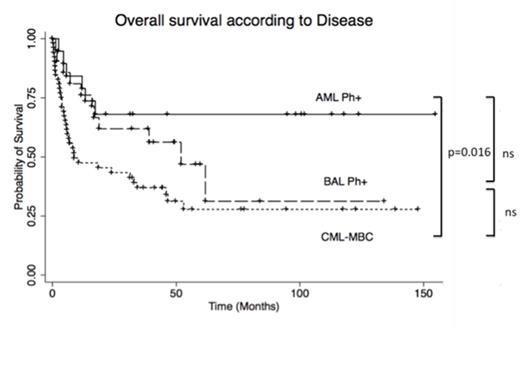Abstract
Introduction: De novo Ph+ acute myeloid leukemia (AML) has recently been described as a distinct AML subtype with a specific genome signature compared to chronic myeloid leukemia (CML). Although Allo-SCT is often proposed as the curative option, the outcome of Ph+ AML treated with Allo-SCT remains unknown in the literature.
Methods: Between 2000 and 2012, 19 patients with Ph+ AML who received Allo-SCT were identified in France and compared to 21 patients with Ph+ biphenotypic acute leukemia (BAL) and 52 patients with myeloid blast crisis CML (MBC-CML). Clinical data were prospectively collected though ProMISe (Project Manager Internet Server), an internet-based system shared by all centers of The French Society of Bone Marrow Transplantation and Cell Therapies. The study was approved by local ethical committee.
Results: For AML, BAL and MBC-CML patients, the median age per group was respectively 46 (18-67), 36 (18-52) and 36 (18-63) years. Median follow-up was 24 months. Additional cytogenetic abnormality was not different between the 3 groups. The MBC-CML group had a lower rate of induction therapy before Allo-SCT compared to the 2 other groups and a lower rate of remission status before transplant (p<0.0001). However tyrosine-kinase inhibitor (TKI) exposure during induction was similar in each arm. A myelo-ablative conditioning regimen was used in 72% of cases without difference in each group. However the Ph+ BAL group received significantly more TBI-cyclophosphamide conditioning regimen compared to the Ph+ AML and MBC-CML groups (p<0.03). No difference was observed between the 3 groups concerning graft source or the use of antithymocyte globulin (ATG). Acute graft-versus-host disease (aGVHD) with a grade≥2 was observed respectively in 37%, 19% and 32% of the Ph+ AML, BAL and MBC-CML groups. Chronic GVHD incidence was 42%, 24% and 27% in the 3 groups. Relapse I ncidence was 28%, 29% and 49% in the 3 groups. Two-year overall survival probability for Ph+ AML, BAL and MBC-CML was 65.5% (45.4-79.7), 58.3% (32.7-71.4), 38.3% (95% CI: 26.2-50.3), respectively (p=0.016, log-rank test, Figure 1). Two-year cumulative incidence of non-relapse mortality (NRM) was 17.7% (0.07-0.4) for Ph+ AML, 25.96 % (0.12-0.49) for Ph+ BAL and 33.2% (0.21-0.49) for the MBC-CML group. In univariate analysis, remission status and type of disease (Ph+ AML) were predictive factors for a better survival rate. The onset of GVHD was also predictive of a better overall survival (HR 0.43 [0.23-0.78], p=0.006).
Conclusion: Limited data are available on de novo Ph+ AML. This study showed a promising 65% two-years overall survival in Ph+ AML subtype in comparison with others Ph+ acute leukemia.
No relevant conflicts of interest to declare.
Author notes
Asterisk with author names denotes non-ASH members.


